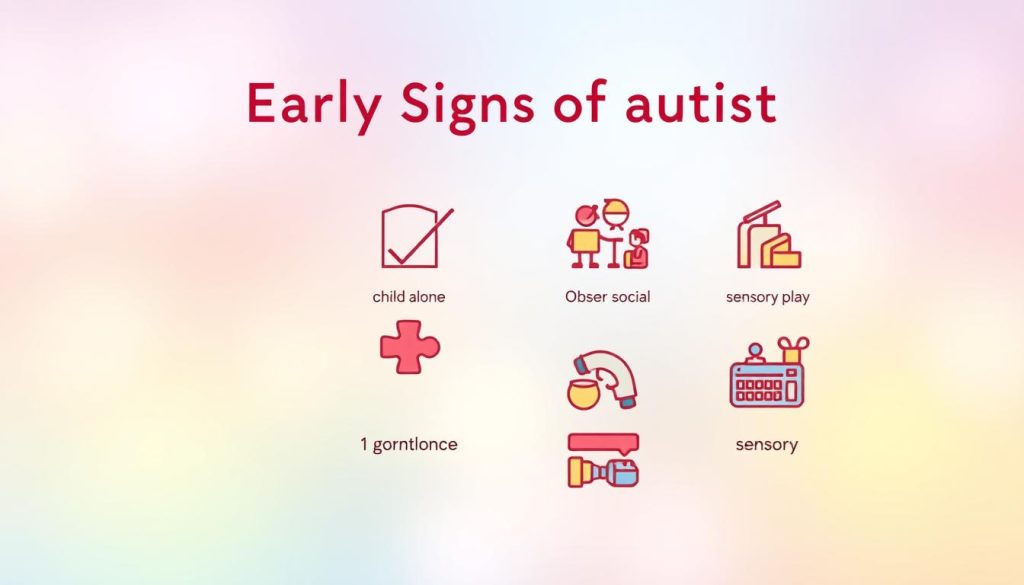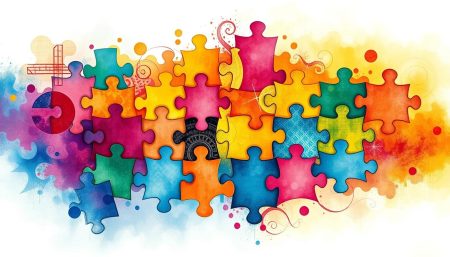Exploring the symptoms of autism spectrum disorder (ASD) is key to early autism intervention. ASD is a complex disorder that affects how people interact and behave. It’s important to understand these symptoms to offer the right support and find helpful resources.
Spotting the signs of autism is the first step. These signs can range from very subtle to quite obvious. It’s vital to remember that everyone with autism is different. This means we need to tailor our support to each person’s needs.
Thanks to top health organizations and ongoing research, we know more about autism than ever. This knowledge helps us understand the symptoms better.
Knowing about ASD helps us fight myths and build empathy. As we move towards a world that values all neurological differences, it’s our duty to address autism symptoms with care and accuracy.
The Spectrum of Autism
Autism is seen as a spectrum, which is key to understanding autism spectrum disorders. It covers a wide range of symptoms, behaviors, and skills. This spectrum shows why we need to approach each person differently.
By looking into definitions, symptom ranges, and myths, we get a full picture. This is vital for spotting autism early signs and understanding autism spectrum disorder behaviors.
Defining the Autism Spectrum
The American Psychiatric Association’s DSM-5 puts autism under Autism Spectrum Disorders (ASD). It shows that autism can look very different from person to person. This means we must see each person’s autism as unique.
Understanding the Range of Symptoms
Autism symptoms can be mild or severe. Some people may not speak, while others can talk well. Symptoms include trouble with social skills, repetitive actions, and differences in motor and sensory skills.
This wide range makes understanding autism spectrum key for proper diagnosis and support.
Myths and Misconceptions About Autism
Many myths about ASD are not true. For example, not everyone with autism is a genius. It’s also wrong to think all autistic people don’t want to socialize. Many do, but they find it hard.
Knowing these facts helps us be more understanding and supportive of people with autism.
| Myth | Reality |
|---|---|
| All individuals with autism have savant skills | Savant skills are rare; autism manifests in diverse forms with varying abilities |
| People with autism are not interested in socializing | Many individuals with autism desire social interaction but find social cues challenging |
Early Signs of Autism in Toddlers
Spotting autism early is key for helping kids. The Centers for Disease Control and Prevention (CDC) shares important signs to watch for in toddlers. Knowing these signs helps in early diagnosis and support.
Language Delays and Communication Challenges
Language and communication are big clues for autism in toddlers. If a child doesn’t start talking or babbling on time, it’s a red flag. The Journal of Pediatrics notes that kids with ASD might not share sounds or smiles as much.
Limited Social Engagement or Interaction
Social skills are vital for young children. Toddlers with autism might not enjoy games like peek-a-boo. They might also not react when called by their name. Parents often notice these signs first.
Knowing these signs helps you know when to get help. If you see these signs, talking to a doctor can lead to early help. This early support can greatly improve a child’s life with autism.
Core Symptoms Autism Spectrum Disorder
Spotting the main signs of Autism Spectrum Disorder (ASD) is key for early help. The autism diagnosis criteria from DSM-5 point out important areas. These include social communication issues and repetitive behaviors seen early in life.
Some big red flags for autism are trouble with normal conversations, not sharing interests or feelings, and not getting social cues. These signs need quick action with autism screening tools. These tools help find these symptoms fast.
The table below shows the main traits of Autism Spectrum Disorder. It compares typical growth with ASD signs. This highlights the need for early checks and diagnosis:
| Developmental Milestone | Typical Development | ASD Development |
|---|---|---|
| Verbal Communication | Starts to vary conversations by age 3 | Does not start conversations |
| Non-Verbal Communication | Uses gestures and facial expressions by age 2-3 | Uses gestures poorly; has little eye contact |
| Social Interaction | Enjoys group play and makes friends by age 3-4 | Has trouble with social interactions, prefers to be alone |
| Repetitive Behaviors | Repeats actions sometimes as part of learning | Does repetitive actions a lot; wants things the same |
Using autism screening tools early can tell if a child is on the autism spectrum. Spotting these red flags for autism is critical. It helps parents and doctors start the right help early. This can greatly improve a child’s life.
Autism Symptoms in Children: What Parents Should Know
Knowing the signs of autism early helps a lot. Parents are key in spotting odd behaviors. They can use a autism symptoms checklist to keep track of their child’s growth.
Behavioral Symptoms and Repetitive Actions
Repetitive actions are a big sign of autism in kids. This can be hand flapping, rocking, or focusing too much on things. These actions help kids deal with being too sensitive to their surroundings, a common trait in autism.
Differences in Social Interactions and Friendships
Kids with autism often act differently in social situations. They might struggle to make friends or understand social clues. This becomes clearer as they get older.
For more info on autism and its effects, check out this article. It explains that autism isn’t just a mental health issue.
| Behavior | Seen in Typical Development | Seen in Autism |
|---|---|---|
| Response to Name | Usually responds | Often unresponsive |
| Initiating Conversations | Frequent | Rare |
| Playing with Others | Interactive | Prefer solitude |
| Emotional Expression | Varied and appropriate | Flat or inappropriate |
Spotting these behavioral indicators of autism in children helps parents make informed choices. It leads to getting a professional diagnosis and finding the right support for their child.
Detecting Autism in Infants: A Closer Look
Spotting the early signs of autism in babies means watching for certain milestones. These can show if a baby is not growing as expected. The CDC and other health groups say it’s key to watch how babies act early on.
Autism early signs can be small changes in how babies react to their world. For example, if a baby doesn’t babble on time, doesn’t look at you, or doesn’t smile much, it’s something to notice. Parents and doctors should keep an eye out for these signs.

- Social Engagement Delays: It’s important to see if the baby responds to people and things around them.
- Communication Hurdles: Watching how a baby makes sounds, gestures, and later, words is key.
- Repetitive Behaviors: If a baby keeps doing the same thing over and over, it could be a early sign of autism in babies.
If you notice anything unusual about your baby’s development or behavior, talk to a pediatrician. They can check for autism symptoms in children and help figure out what’s going on.
Red Flags for Autism: When to Seek Professional Advice
Spotting early red flags for autism is key for early help and support. Parents and caregivers should watch their child’s growth and how they interact with others.
Monitoring Your Child’s Development Milestones
Watching developmental milestones is a smart way to check if your child is on track. The National Institute of Child Health and Human Development (NICHD) says it’s important to see how your child plays, learns, speaks, and acts. If they’re not meeting these milestones, it might be time for a check-up.
Healthcare experts have tools and guidelines to help you keep an eye on these milestones.
Responding to Early Warning Signs
The American Academy of Pediatrics stresses the need for regular check-ups to catch autism early. Signs like not pointing to objects by 14 months or not playing pretend games by 18 months are important. Also, if your child’s language or social skills suddenly get worse, see a doctor right away.
| Age | Expected Milestone | Red Flag for Autism |
|---|---|---|
| 12 months | Babbling | Lack of babbling |
| 14 months | Pointing to objects | No pointing gestures |
| 18 months | Playing pretend games | Avoiding pretend play |
| 24 months | Two-word phrases | Lack of combined words |
For more on ADHD and developmental disorders, check out this article. It talks about ADHD’s link to developmental disorders and the importance of early intervention.
Understanding Autism Diagnosis Criteria
Understanding autism diagnosis is complex. It needs a deep grasp of the criteria and teamwork with healthcare experts. Getting a diagnosis is key for early support and help.
Diagnostic and Statistical Manual of Mental Disorders (DSM-5) Guidelines
The DSM-5 is a key guide for mental health professionals. It sets out clear autism diagnosis criteria. To diagnose Autism Spectrum Disorder (ASD), look for signs of trouble in social communication and interactions.
These signs include trouble with social-emotional exchanges, nonverbal communication, and keeping up with relationships. Also, look for repetitive behaviors, such as odd movements or a need for sameness. These behaviors are key signs.
Working with Healthcare Professionals for Diagnosis
Getting a correct diagnosis needs a team of experts. This team includes doctors, psychologists, and neurologists. They use autism screening tools to understand the child’s situation.
This team effort is vital. It helps tell autism apart from other conditions. This ensures a diagnosis that fits the child’s needs.
| Criteria | Importance | Relevance to Diagnosis |
|---|---|---|
| Social Communication and Interactions | Essential for determining ASD | Directly linked to core symptoms of autism |
| Behavioral Patterns | Critical for diagnosis | Helps differentiate from other disorders |
| Use of Screening Tools | Integral to diagnostic process | Ensures a full evaluation |
Autism Spectrum Disorder Behaviors and Interventions
Autism Spectrum Disorder (ASD) brings many challenges that need special help. It’s important to tailor help to each person’s needs. This helps them manage their daily life better.
Behavioral therapies and autism intervention strategies are key in this effort.
Applied Behavior Analysis (ABA) and Other Therapies
Applied Behavior Analysis (ABA) is a main approach in helping ASD. It aims to improve behaviors like social skills and communication. It uses positive reinforcement to do this.
Other therapies like occupational therapy and speech therapy also help. They support ASD children in becoming more independent and social.
Strategies for Parents and Caregivers
Parents and caregivers play a big role in helping ASD children. They need to create structured environments and use visual schedules. Consistent routines are also important.
These steps help improve communication and life skills. They are key to the child’s growth and development.
| Intervention Type | Focus Area | Examples |
|---|---|---|
| ABA | Behavioral Adjustment | Positive reinforcement techniques, Behavioral modeling |
| Occupational Therapy | Sensory and Motor Skills | Sensory integration activities, Coordination exercises |
| Speech Therapy | Communication Skills | Language development, Articulation practice |
| Social Skills Training | Interpersonal Interaction | Group therapy sessions, Peer interaction scenarios |
Using these therapies in a supportive setting can make a big difference. It helps ASD individuals become more part of society. They can lead more fulfilling lives.
Signs of Autism in School-aged Children
Spotting autism symptoms in children at school age is key for their learning and social growth. The Individuals with Disabilities Education Act (IDEA) helps by providing special educational programs. But, finding these signs early is vital.
Academic Challenges and Support
Children with autism face unique learning hurdles that can hurt their grades. They might struggle with changes, be sensitive to sounds, or have trouble with planning. By creating special education plans (IEPs), we can help them reach their academic goals.
Social Skills and Extracurricular Activities
Teaching social skills is also important for kids with autism at school. They might find it hard to connect with friends or join in group activities. But, by joining structured groups and clubs, they can learn to interact better and feel more confident.
| Challenge | Support Strategies | Expected Benefits |
|---|---|---|
| Transitions and Routines | Visual aids, tailored schedules | Improved task completion and stability |
| Sensory Sensitivities | Use of sensory tools, controlled environments | Better focus and engagement in learning |
| Executive Functioning | Organizational aids, step-by-step guidance | Enhanced organizational skills and independence |
| Social Interaction | Social stories, peer-mediated activities | Improved social skills and peer relationships |
Autism Early Signs: Observational Checklist
Spotting autism early is key for early help. A good autism symptoms checklist is very helpful. It helps in noticing signs of autism and figuring out what each person needs.
By watching and writing down behaviors, we can spot important signs. These signs might show if someone has autism.
What to Include in Your Checklist
The Autism Research Institute suggests a checklist that covers many areas. It should look at social skills, like not making eye contact or not wanting to share. It also looks at communication, like slow speech or trouble with words and gestures.
It also checks for repetitive actions or getting upset easily when things change. These are signs that might point to autism.
Using the Checklist to Recognize Patterns
Keeping track of behaviors and growth is important. This helps in spotting patterns that might mean autism. Keeping a record helps doctors understand better and make the right plans.
Talking to doctors or child development experts about your concerns is important. This way, everyone works together to help and understand the situation better.

Autism Symptoms Checklist for Early Identification
An autism symptoms checklist is key for spotting autism early. It helps track autism symptoms in children in a clear way. This tool is vital for knowing when a child needs a professional check-up and helps start early help sooner.
Using an autism symptoms checklist means looking for certain behaviors and traits linked to ASD. Here are some main areas and examples to watch for:
- Communication Skills: Delayed speech, few gestures, hard to keep a conversation going.
- Social Interaction: Not making eye contact, not interested in friends, hard to get social hints.
- Behavioral Patterns: Doing the same thing over and over, needing things the same way, very focused on certain things.
- Developmental Milestones: Not reaching milestones on time, or suddenly losing skills.
Spotting autism early leads to better results with early help. The checklist helps parents and caregivers understand autism symptoms in children. It also helps them talk to doctors about their worries.
Autism Screening Tools for Healthcare Providers
Early screening and intervention are key in managing autism spectrum disorder (ASD). Healthcare providers work together to use autism screening tools for this. The American Academy of Pediatrics says it’s vital to use proven tools to spot ASD signs early.
Standardized Tests and Assessments
Standardized assessments for autism are essential for a precise diagnosis. These tools check on communication, social skills, and behavior. The Modified Checklist for Autism in Toddlers (M-CHAT) and Ages and Stages Questionnaires are known for their accuracy.
The Role of Pediatricians in Early Screening
The pediatrician’s role in autism screening is vital. Pediatricians are often the first to notice autism signs. They help parents understand if a child needs a specialist’s evaluation.
| Screening Tool | Target Age | Primary Focus |
|---|---|---|
| M-CHAT | 16-30 months | Detecting risk of ASD |
| Ages and Stages Questionnaires | 1-60 months | Overall development screening |
Using autism screening tools and standardized assessments for autism in check-ups helps a lot. Pediatricians’ early involvement can greatly improve ASD management and outcomes for kids.
Managing Autism Spectrum Disorder in Daily Life
Living with autism means finding ways to manage it every day. It’s about understanding what each person needs. It’s also about creating a supportive environment that helps them grow.
Navigating Social Situations and Public Spaces
For those with autism, social interactions and going out can be tough. But, there are programs designed to make these experiences better. These programs aim to make places more comfortable for people with autism.
By doing this, public spaces become places where people with autism can learn social skills. They can also connect more with their community.
Importance of Routine and Structure
Having a routine is key for someone with autism. It helps them feel less anxious and more secure. Families, teachers, and therapists work together to create these routines.
This teamwork helps make sure the routines fit each person’s needs. It brings stability and security, which are very important for people with autism.
By using these strategies, people with autism can reach their full potentials. They can live happy and empowered lives. Every step towards inclusion and understanding is a step in the right direction.
Symptoms Autism Spectrum Disorder: Familiarizing with the Basics
Understanding Autism Spectrum Disorder (ASD) is key. Two main areas are sensory sensitivities in autism and emotional regulation in ASD. These affect daily life and social integration. Knowing about these symptoms is vital for everyone involved.
Recognizing Sensory Sensitivities
People with ASD might react strongly to everyday things. They might find loud noises, bright lights, or certain textures overwhelming. This can make it hard to focus in noisy places or wear certain clothes.
- Visual sensitivities: Bright lights or flashing screens can be overwhelming.
- Auditory sensitivities: Sudden loud noises or ongoing background noise can cause discomfort.
- Tactile sensitivities: The texture of certain fabrics or food textures can be problematic.
Addressing Emotional Regulation
Managing emotions is tough for many with ASD. They might feel emotions quickly or struggle to calm down. Learning to control emotions is important for social life and happiness. Therapies like Cognitive Behavioral Therapy (CBT) help a lot.
- Identifying triggers: Knowing what causes emotional reactions helps manage them better.
- Coping strategies: Using deep breathing, imagining calm scenes, or stress balls can help.
- Support systems: Having a network that knows how to help when emotions get high is key.
Dealing with sensory sensitivities in autism and emotional regulation in ASD needs personal plans. Understanding these challenges is not just helpful; it’s essential for a better life for those on the autism spectrum.
Living with Autism: Real Stories, Challenges, and Triumphs
Living with autism is a journey full of ups and downs. It’s a path filled with challenges in talking to others and reaching personal goals. Each story is different, but they all show the strength and resilience of those living with autism.
Families fight for better education, and adults push for jobs that include them. These efforts lead to moments of joy, like a child’s first smile or an adult’s big achievement. These moments celebrate the person’s success and show how far we’ve come in understanding autism.
Stories and studies paint a picture of life with autism. They highlight the importance of support from family, teachers, employers, and friends. By sharing these stories, we build empathy and acceptance. This shows that life with autism is full of challenges, but also full of hope and beauty.
FAQ
Q: What are the common symptoms of Autism Spectrum Disorder?
A: Common symptoms include trouble with social interactions and communication. People with ASD may also have repetitive behaviors or interests. Each person’s symptoms can be different.
Q: What constitutes the autism spectrum?
A: The autism spectrum includes a range of conditions. These conditions have varying degrees of social communication issues and repetitive behaviors. People with ASD have different needs and abilities, from non-verbal to advanced language skills.
Q: How do myths and misconceptions affect the understanding of Autism?
A: Myths, like thinking all with autism are savants, can cause misunderstandings. It’s important to clear up these myths. This helps us understand and support people with ASD better.
Q: What are early signs of autism in toddlers?
A: Early signs include delayed speech and not babbling. They also include trouble with back-and-forth communication. And not sharing smiles or other facial expressions.
Q: What are the core symptoms of Autism Spectrum Disorder?
A: Core symptoms include social communication deficits and repetitive behaviors. These symptoms must be present from early childhood and cause significant impairment.
Q: What should parents know about autism symptoms in children?
A: Parents should look for behavioral symptoms like repetitive actions. They should also notice social interaction differences, like trouble making friends. These signs can help guide them in seeking professional help.
Q: How is autism detected in infants?
A: Autism in infants is detected by watching for missing or delayed developmental milestones. This includes not babbling, not smiling socially, or not making eye contact. These are compared to typical developmental timelines.
Q: What are the red flags for autism that indicate the need for professional advice?
A: Red flags include not pointing to objects by age one. Not playing pretend games by 18 months. Or experiencing a sudden regression in language or social skills at any age.
Q: What are the guidelines for autism diagnosis according to the DSM-5?
A: The DSM-5 guidelines say a diagnosis of autism requires persistent social communication and interaction deficits. These must be across multiple contexts. And there must be restrictive, repetitive patterns of behavior.
Q: What interventions are effective for Autism Spectrum Disorder behaviors?
A: Effective interventions include Applied Behavior Analysis (ABA), occupational therapy, speech therapy, and social skills training. These help address ASD behaviors.
Q: What are signs of autism in school-aged children?
A: Signs include academic challenges and trouble with transitions. Sensory sensitivities and issues with social skills and extracurricular activities are also signs.
Q: How can parents use an observational checklist for early signs of autism?
A: An observational checklist helps parents document behaviors and patterns. This information can be shared with healthcare providers. It aids in the early detection and diagnostic process.
Q: What does an autism symptoms checklist for early identification include?
A: It includes items related to communication, social interaction, behavioral patterns, and developmental milestones. This helps in early detection of ASD.
Q: What are standardized autism screening tools for healthcare providers?
A: Screening tools like the Modified Checklist for Autism in Toddlers (M-CHAT) and Ages and Stages Questionnaires are used. Healthcare providers use these for early identification of ASD.
Q: How do routines and structure affect the daily life of someone with autism?
A: Routines and structure provide predictability. This can reduce anxiety and improve coping mechanisms. It also supports better management of daily activities for individuals with ASD.
Q: What are sensory sensitivities and emotional regulation in Autism Spectrum Disorder?
A: Sensory sensitivities involve aversion to certain stimuli. Challenges in emotional regulation can lead to meltdowns or shutdowns. This happens when individuals with ASD become overwhelmed.


















